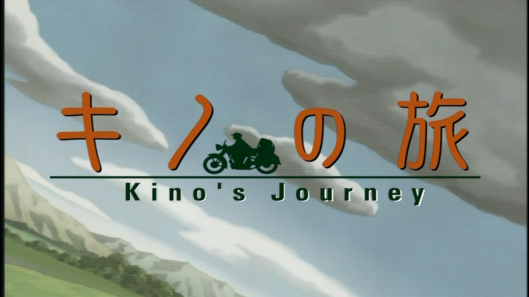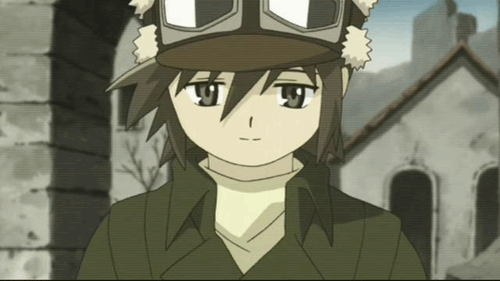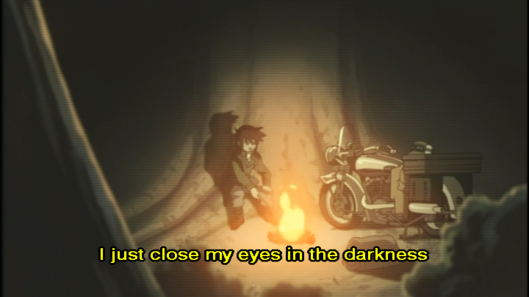Tags
Analysis, animation, Anime, anime harvest, anime review, body language, cartoon, communication, episode 1, facial language, Hermes, Japanese animation, Japanese anime, Kino, Kino's Journey, lang, Langs End, LangsEnd, language, light novel, manga, pensive anime, Purpose, relationships, review, the anime harvest, this week on
This should be the first time I’m putting one of these on The Artifice, so I should probably explain what this is about. “This Week On” is for when I examine an anime or manga series one episode or volume at a time. Doing things like this lets us look at the little details that a typical review or full series analysis might overlook. Also, because each episode of a show should usually have its own arc, themes and directorial goals, each “This Week On” can answer to those specific demands.
The exact formula and goal isn’t exactly nailed down. We’ve covered simulcast anime as each episode comes out, older mystery manga that I never read before; so far I’ve always gone in blind, and it’s been pretty casual. This time I’m hoping to change one of those things.
Kino’s Journey is a 2003 anime based on a series of light novels by Keiichi Sigawa. It’s something I’ve never watched beyond the first episode, but have been meaning to for a while and, from what I understand, it is very episodic, so once again this will be blind. What will be different is that I’m actually going to watch the whole episode before putting a single word down. Okay? I hope you enjoy.
Premise & Synopsys:
I just said this isn’t going to be distracted by the overarching elements of the series as a whole, and now I’m starting off by explaining what the series as a whole is about. But, in my defense, you probably want to know what the hell is going on.
Kino’s Journey is about the girl, Kino, who travels through a low-key fantasy world with her talking motorcycle, Hermes. She visits different countries, learns of or encounters something interesting and thought provoking about them, and then moves on. That’s really all there is to it. Tonally it’s a lot like Haibane Renmei or Mushishi; very slow, and quiet, and pensive.
The synopsis for this episode is, and get used to this line, Kino and Hermes enter a new country. In this one the first thing the two notice is that there are no other people. They’re cleared through the gate by an automated customs machine, and Kino goes to a restaurant where robots serve, and presumably cook, the food. She’s surprised how cheap it is too. Then she and Hermes check-in to a hotel for the night, and again are surprised by how nice the room is and how little it costs. In their first day in the country they don’t see a single person, and both think they place is completely deserted.
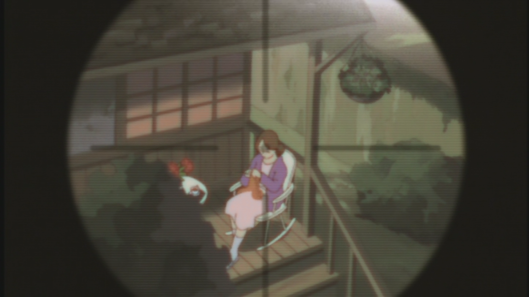
Near the end of their second day, Kino finally finds people when looking through her telescope, but they all stay close to their own homes, and away from others. Kino and Hermes go back to the hotel for the night, and talk a little about Kino’s traveling philosophy. Apparently she only stays in a place for three days, which means tomorrow will be their last day here.
On the third day, while driving around, Kino and Hermes get closer to the people. They run inside and close their windows when they see the two coming. Eventually they run into a man who stops being scared of Kino when he realizes that he can’t read her mind, and she can’t read his. Finally we get some answers.
The man invites Kino into his house and explains that the country used its advanced technology to make a serum that gave people the ability to know others’ thoughts. They did this because the people believed that the pain people inflict upon one another could be avoided if people simply understood how others felt. Communicating through languages can convey ideas, but not thoughts themselves or feelings, and they are inefficient and easily misunderstood. By knowing each other’s thoughts, people would be able to understand others’ intentions and feelings. It’s a very interesting idea, but it wasn’t the perfect solution they were hoping for.
This may shock some of you, especially here on the internet where everyone is so nice and friendly, but sometimes, people don’t like you. Especially you, with the stupid face. They think your face is stupid. Even little things, like different tastes in music, could end loving relationships. It culminates in this End Of Evangelion looking nightmare.
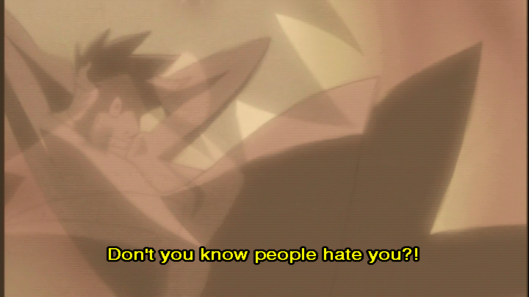
So the people just stopped seeing one another. They realized that it was easier to each stay in their own homes, too far from anyone else to know their thoughts, and have the robots take care of everything else. The man realizes that this means his will probably be the last generation the country will ever see, but that’s the way it is.
The Opening:
Openings are something of a staple in anime. They’re so important that a lot of critics dedicate sections of their reviews just to cover them, and usually the endings as well. While some openings, like Baccano!’s “Guns & Roses”, are deigned to be watched before each episode, most are primarily about that very first experience seeing the show. They convey the very first breath of the show to the audience.
The OP for Kino’s Journey is “All the way”. It opens on Kino’s hands on the handle and foot on the pedal of her bike, followed by the motor shaking and the exhaust, umm… exhausting. In two seconds it has established not necessarily movement, but moving on. The bike is just starting up and Kino is leaving wherever she is. Where is that?
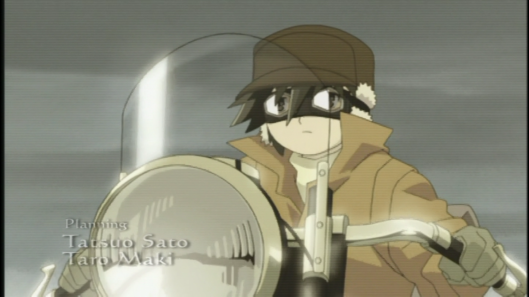
We don’t really know. All we ever see is Kino and Hermes, and a grey sky behind them. Sky usually denotes freedom, or openness, but the grey indicates a melancholy mood. And that’s how, in three seconds, Kino’s Journey tells the audience exactly what to expect from the show itself. Traveling, a lot of leaving without looking back, freedom, and a whole lot of grey space.
The word freedom gets thrown around a lot, generally in a positive light. But freedom isn’t all blue skies. To try to look smart by quoting people who are actually smart, let me quote Jean-Paul Sartre when he said, “Man is condemned to be free; because once thrown into the world, he is responsible for everything he does.” Or to put it another way, sometimes having to make decisions sucks! And living with them can really suck. Like, Yoko or Nia? I can’t pick! Why can’t God release me from this agony and just assign me a waifu?! Kino is free to go wherever she chooses, but it’s always something she has to choose.
This isn’t just telling us that Kino carries a gun (actually, if you’re observant you can garner that from an earlier shot), it’s trying to surprise us with that fact. Given Kino’s character design, most people probably wouldn’t expect her to be packing heat, or being able to pull it out so casually. This shot doubles down on how out of character that seems by actually surprising us with it. It tells us two things; 1) there’s more to Kino than meets the eye (and now that I’ve said that, I’m disappointed Hermes isn’t a transformer), and 2) there is some reason for her to need this weapon.
All of this contributes to the anime’s first message to the audience.
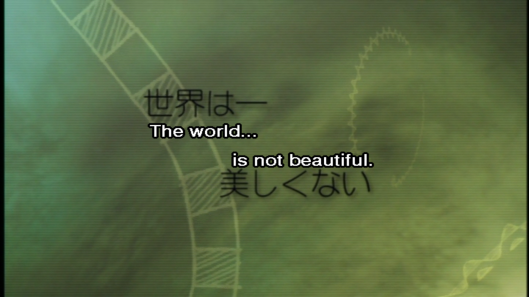
Oh man, this is getting deep on us! But I don’t want this to give the wrong impression. We do see Kino smiling and even laughing at parts in the opening, and the entire sequence is met with some light, cheery music. I think the impression we’re supposed to get from all this is that Kino’s Journey is never black or white; it’s many shades of grey.
Purpose:
So the first third or so of this episode has been completely left out of the synopsis, because I don’t think it’s really part of this episode. It depicts Kino and Hermes wandering through a desert before they find the country of the week. It is an introduction to the characters and premise, and some themes that will likely continue throughout the series. But, these themes are also built upon in the episode proper, so that’s enough of an excuse for me talk about them.
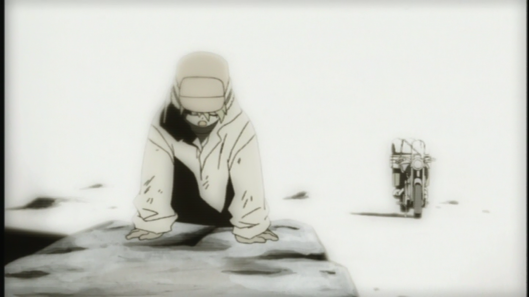
Kino says that her purpose is to travel, while Hermes’ purpose is to drive. This comparison highlights a key difference between Kino and Hermes that, thanks to years of the mind-rotting influence of this anime junk, I didn’t notice right away. Hermes ain’t no person!
This is illustrated when Kino brings up her and Hermes’ “purposes”. Her own purpose is to travel, which is something she presumably chose for herself. She’s decided that traveling is her purpose; her purpose comes from herself. But Hermes is a machine, one specifically created to drive, so his purpose comes from someone else; what someone else made him for.
This establishes Hermes role, relative to Kino. Hermes is a supporting character. He is there to give Kino someone to talk to and be a means for Kino to travel, as well as being a cool ass talking motorcycle, but he has no goals or ambitions. While Kino doesn’t either, at least not in any traditional protagonistic (that sounds SO much like it should be a word) sense, she has decided to travel, while Hermes has no reason to even try to decide anything, because he can’t do anything. We never see Hermes actually exert any will; he moves when Kino rides him or pushes him and he can talk, but on his own he is powerless. We learn this when he talks about what will if Kino dies in the desert. Hermes says he will be stuck there, slowly getting “buried under millions of grains of sand, right where [he] sit[s].”
Despite this asymmetrical dependence, Hermes doesn’t seem unwilling to accompany Kino. He is critical of her recklessness, but supportive. They communicate as equals.
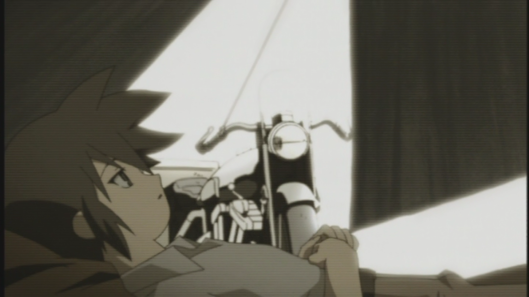
Defining equality isn’t easy to do. I’ve seen it presented as everything from tyranny to anarchy (and that’s just from Kill La Kill), and so I may be wrong in calling it out here. But I got the impression of equality from one brief exchange between Kino and Hermes. While trapped in the desert, without much of a plan, Hermes tells Kino, “… it’s decision time. You must choose…” “Kino, the most important asset to a traveler is decisiveness. This holds true for both rookie and veteran. Am I wrong?” That “Am I wrong?” at the end is important. It invites a response from Kino, but isn’t a question in the same way a first grader asks their teacher if they got a right answer.
And respond Kino does. “Hermes, a traveler’s most important asset is what helps you get back up after a struggle’s left you so close to the end.” “What’s that?” “I know it as luck.”
While the ideas thrown around in this exchange are interesting in themselves, what’s more important is that it’s happening at all. While Kino and Hermes have different philosophies on traveling, they are able to discuss them, not argue over them, openly. That is what, I feel, conveys them as equals.
Relationships/Communication:
I don’t think you need me to point out that this episode is primarily about human relationships and the ways communication plays into them. The man… does he have a name? Hold on a second… [Da da-da da-da~, creating the impression of time passing in a non-temporal medium really sucks~] Huh, he’s just listed as “The Loney Man”, but Jay Hickman did his English voice, so we’ll just call him Jay. Jay lays it all out pretty nicely, and it’s all very sad, and would make you think Kino is a dark anime. But one detail you may have missed is this.
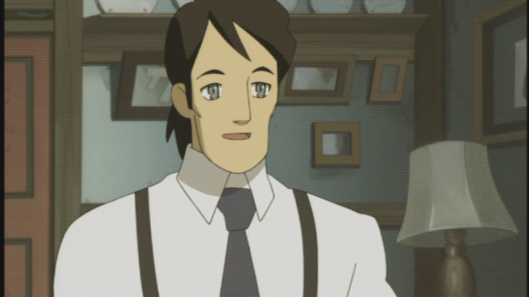
See it? Jay has shaved, and tidied his hair up a bit. This tiny detail, I think, gets to the heart of why this episode is a little more optimistic than it lets on.
To understand this, first we have to ask why the Jay shaved, and why he wasn’t shaved in the first place. Why he wasn’t shaved when Kino and Hermes first arrived is obvious; he wasn’t going out, like, ever. He didn’t think he was going to talk to anyone anytime soon, maybe not for the rest of his life, so he probably thought, “Why bother?” But when Kino showed up, he wanted to put his best foot forward; present himself nicely. After all, isn’t that why all men shave, or at least groom, their facial hair? To put forward a good image of themselves? To convey the message that they are clean-cut? Or more generally, communicate something. It’s a form of body language.
People generally think body language is limited to the movements people make and the way they hold themselves. Eye twitches, or sitting cross-legged, or flipping someone off.

But it actually encompasses a lot more of how people visually present themselves, including clothing, and hairstyles. So why would Jay, a guy simultaneous so eager to speak to someone for the first time in who knows how long, yet so aware of how flawed verbal communication can be, stop to shave here? Because, whether Jay is conscious of it or not, body language is the solution all his communication problems.
We see this again when Kino leaves. The last exchange between her and Jay isn’t in words, but in expressions. Kino smiles at him and he smiles back. This completely changes the mood of the scene from depressing and lonely, to warm, as Kino and Jay understand each other.
The episode ends closing this theme off, as Kino tells Hermes what she was trying to express in that smile, and she wonders if the man understood. Body and facial language is a lot less clear then even the verbal language Jay just explained to us is totally unclear! But body language is surprising good at conveying the things spoken language is poor at. While JAy probably didn’t get the exact message Kino meant to send with that smile, it did communicate something to change the mood in a way nothing Kino could have said would have.
It’s not perfect, and it doesn’t have the idealistic ambitions of the scientists who invented the mind reading serum, but that’s exactly why it’s beautiful. The episode ends on “The world is not beautiful: therefore it is.”
Robots and World Building:
Finally we have what is probably my favourite part of the first episode of Kino’s Journey, the ingenious use of those mini, unpiloted mechs. Sorry, my editor’s trying to tell me something. What was that? ‘the hell’s a robot?!
The robots (am I saying that right?) in this episode do three things. They establish some essential sciency stuff, they help the audience realize something’s up, and allow the story to go on.
When Kino and Hermes arrive, they start to think that there is nobody in the entire country; that the whole place is run by these automatons, which it sort of is. They handle the customs duties, service jobs, cooking, managing hotels, and they do this all without needing a human nearby to control them or take care of some occasional maintenance. This would require not only highly advanced robotics, but also highly advanced AI, which in turn would require advanced neuroscience.
Both of these things turn out to be necessary for the country to function the way it does. If people didn’t have these robots to handle everything, they would have to go outside themselves and come in contact with people. And if they didn’t have an advanced understanding of neurology, they couldn’t have developed the mind-reading serum in the first place. The robots Kino and Hermes have been interacting with this whole time exhibit the kinds of technology a state would need in order to become like this.
Next, it gives the audience the sense that something is off. Kino comments that the food at the restaurant was not only quite good, but also pretty cheap. She says something similar when she and Hermes get to the hotel, and find their room is fit for a king, yet affordable for a jester. It just seems odd. If everything is so good, and the prices aren’t scaring anybody away, then where the hell is everybody?
While the characters ask this same thing themselves a couple times, the never beat you over the head with it, because they don’t have to. The anime is able to convey this message without having Kino and Hermes prattle on about it. The lack of anyone enjoying the convenience of this robot run region is just too weird, and it naturally makes the viewer wonder about it.
And the best part of these machines, they let stuff keep happening. Usually, in a ghost town setting like this, the characters would run into a brick wall somewhere along the way, probably while stopping for gas or trying to check in to a hotel. They would then get sidetracked trying to find out where all the people are, and the plot would develop from that. That’s fine, but it wouldn’t fit with Kino’s Journey.
Kino doesn’t solve mysteries or fix problems. She is a traveler; she comes into a new country, takes a few days to experience it, and then moves on. The robots here allowed here to continue experiencing this country, without getting sidetracked by the lack of people. Thanks to them, she could have just as easily left the country without ever seeing anyone and not much would have been different. And that’s what makes this show what it is. It’s not Kino’s Quest. She is a traveler. She just passes through places, then moves on.
Don’t Los- OH! I just realized the irony of naming Jay after his voice actor! Uhh… Neat.
Don’t Lose Your Way

